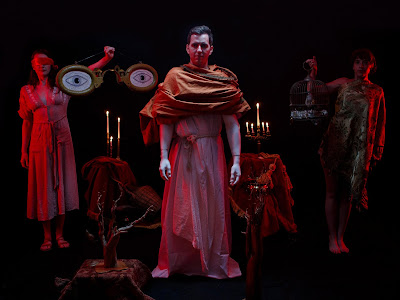The less said about Sister Tempest's story the best, as one of its chief pleasures is to see how the plot steadily reveals more and more surprising layers. Its framing story involves two close-knit sisters who have to fend for themselves after a family tragedy. Anne Hutchinson (played by Kali Russell in a powerful performance) watches over and raises her younger sister Karen (Holly Bonney) as if she was her own daughter. After Karen mysteriously disappears, Anne's life falls apart until she meets and develops a sisterly relationship with Ginger Breadman (Linnea Gregg), a young student of hers at an all-girls art school. Eventually, Ginger's relationship with Anne starts to mirror her previous relationship with her missing sister Karen, whom Anne has never fully gotten over.
Built around this central framing story is a dark and twisting deep dive into the inner psyche of Anne, whose fragile mental state steadily falls apart until we are essentially viewing the mind-scape of what may be a schizophrenic. Badon fills Sister Tempest with alternately shocking and aesthetically gorgeous visual tableus that reflect Anne's deteriorating mental state. We are witnessing both an unsettling portrait of a woman gradually descending into insanity, as well as a blissful examination of the bonds of familial love.
The visual references in Sister Tempest range from Japanese kaiju films like Godzilla, to 1950s cult classic science fiction Hollywood films like the Day the Earth Stood Still and The War of the Worlds. Major figures in Anne's life manifest themselves as pop culture representations from the world of cinema, painting, as well as comic books. Badon, who is also an accomplished visual artist himself, stages several scenes in Sister Tempest against colorful, animated backdrops, giving the film the feel at times of a live-action manga. Near the end of Sister Tempest, Badon even includes a clever reference to Marvel superhero films and Japanese anime.
What makes Sister Tempest such an astonishing achievement is that Badon has been able to create eye-popping special effects and set designs at a fraction of the cost of a typcial Hollywood blockbuster film, but with even more imagination and visual flair. Badon created elaborately constructed miniature sets for many of his major locations (as an homage to similar sets from the classic Toho Studios Godzilla films), and the psychedelic costume and creature designs fit his overall pop-culture, retro 1950s aesthetic. Oftentimes, the digital CGI effects of modern day Hollywood films feel hollow and artificial, but Badon's practical effects and hand-crafted set design feel visually alive and authentic.
Most of all, Sister Tempest is a reminder that there are still possiblities for cinema to continually innovate as an artform, and to embrace new forms of visual and narrative storytelling. Sister Tempest's continuous parade of hallucinatory sequences can enduce an almost trance-like state in the viewer, resembling what Jodorowsky was attempting to accomplish in his late career films The Dance of Reality and Endless Poetry. Like those films, Badon approaches cinema as the ultimate, mind-altering experience. Indeed, at times the dream-logic and startling use of colors in Sister Tempest resembles an acid trip; one that begins as a horrifying nightmare, but gradually evolves into a peaceful dream about sistery love.





No comments:
Post a Comment